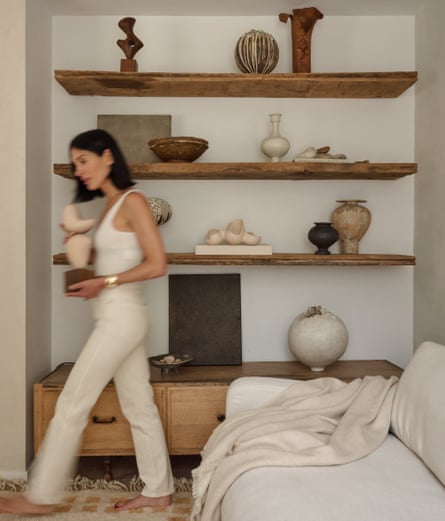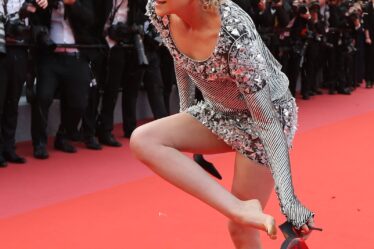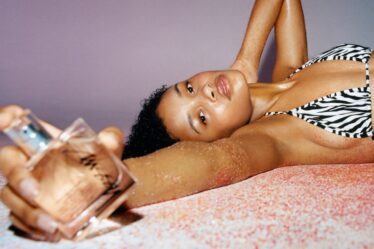
My induction into the world of “stealth wealth shelves” began while I was house-hunting last winter. It was the 43rd place we’d viewed, and over-budget – but I was grabbed by the photos on Zoopla: the pink pendant light, terracotta-tiled kitchen and, most intriguingly, a shelf of carefully spaced out artful ceramics and strangely shaped vases. Up close, this shelf resembled an installation. Yet I had the strange feeling I’d seen it all before.
This past year, fashion has been dominated by a look known as “stealth wealth”. These clothes don’t use branding in the traditional way – flashy logos, say, or monograms. Instead, they rely on insider knowledge, an “if you know, you know” fabric or colour, to hint at their value. See the navy Loro Piana caps on Succession, the cream polo neck jumper by The Row worn by Gwyneth Paltrow at her trial of the century, or Coleen Rooney’s beige Dior trench on the cover of Vogue. Now the stealth wealth look is coming for your home.
You may have seen some of these pieces on social media: chunky granite candlesticks, paint-drip vases, a neon bust and those white marble link rings (what even are they?). It doesn’t necessarily matter where they’re from, or how much they cost. Like their clothing counterparts, they are almost forgettable – but to a discerning eye, mark you out as someone with taste.
As Edward Behrens, editor of Apollo art magazine, says: “It’s about owning and projecting an aesthetic that you want people to know you are part of, even if it has nothing to do with who you are.”
Just as the rich never dress like they’re rich, the stealth wealth shelf never reveals much about its owner. There are no family heirlooms or children’s art, but a hefty Taschen tome used as a plinth or some random books, placed back to front so as to complement your neutral colour palette, are encouraged. As for greenery, don’t expect to see monsteras and bamboo (you’re not a student) but rather market-fresh flowers of the season – mimosa and peonies are go-tos – or a bit of eucalyptus in an apothecary-style bottle.
Vintage and one-off pieces may be dotted about, too, though only those that fall under the category of “hipstoric” – hip, yet historic. They may be arts and crafts pieces sourced on Vinterior, which are having a comeback, or any knick knacks by Vitra Eames. This is no place for mum-core decor about it being “wine o’clock somewhere”. As a rule, the stealth wealth shelf hinges on objets that whisper rather than objects that scream.
Once confined to the pages of Architectural Digest and Elle Decor, stealth wealth shelf #inspo is even cropping up on the high street – see Mango and Soho Home, La Redoute and the Howdens catalogue, which all feature semi-bare shelves and empty vessels. But it’s Instagram that has normalised it. At a time when your entire home can be art directed online for likes – see Athena Calderone and Gabby Deeming, who turned the world on to monastic colours and floor-to-ceiling Crittall windows, now available through collaborations and how to classes. It doesn’t even matter if you like the thing or not. You just need to have it.
As trends go, it’s a natural extension of the ongoing obsession with elevated homeware, beloved by the generation who once coveted avocado on toast, subway tiles and £40 hand soap. Of its various origin stories, though, I’d trace it back a decade to US ceramicist Isaac Nichols’ boob pots. These wonky vessels plastered with breasts went from tongue-in-cheek interior to the shelves of Urban Outfitters to the must-have item of 2013 seemingly overnight. Other ceramicists copied them, and they proliferated globally.
Sitting between scented candles and diffusers, the boob vase came to define a certain late-noughties millennial home (they even experienced a second wind during the #freethenipple movement). To own one marked you out as a tastemaker, and a feminist. What did it matter that all your friends had one, too?
Since the boob pot, other stealth objets have come and gone: ironic Staffordshire dogs, the Eames house bird and even the Diptyque candles that dominated lockdown. But this is because the stealth wealth shelf is as much about the curation as the stuff: it must all be painstakingly spaced out at eye or Zoom-level, on a shelf or mantelpiece. Individually they might look a bit flat. But as a group, mixed and matched with concrete candlesticks, they make you look like an art collector.
So why are we buying the same things as everyone else? The issue is perhaps that we don’t always have confidence in our own taste. “So much of our domestic lives is informed by a branded aesthetic principle,” says art critic Thomas Marks. That’s why we have things like Henry vacuums or Smeg fridges, items that aren’t necessarily the best at their job, but look the part.
In some ways, it was ever thus. At school, you were nobody without a lava lamp in the window. At university, it was an Ikea PS watering can and a dying monstera on top of your Lack side table – and I lost count of the number of Cath Kidston posy duvets I saw in flatshares. So we all shopped at the same places – so what? These items were hallmarks of a cost-conscious solidarity. The overall effect was almost tribal.
It wasn’t always this way. Growing up, I remember friends’ homes filled with shelves of family plates and heirlooms. They were there for show – but they were also personal; they meant something to the people who lived around them.
Behrens isn’t so sure: “The phenomenon of manufacturers mass producing beautiful things that people showed in their homes is as old as time,” he says, citing Wedgwood plates as an early example. “What has shifted is the aesthetic and the significance of what is shown.” He describes the current crop as “production line ceramics given the trappings of exclusivity, so that they seem even more desirable”.
“Treating a vase as a purely aesthetic object rather than, say, a vase, is part of the problem,” says vintage curator Sasha Wilkins. “Things need to have purpose, and to mean something to whoever bought it.”
Wilkins buys and sells vintage pieces in the Cotswolds, and thinks the temptation to buy the same things as everyone else is largely “a metropolitan issue.
People either don’t know where to buy eclectic stuff in London, can’t afford to, or simply don’t know what they want.” Over half of her customers are from cities, she says. “They rely on people like me to curate that taste.”
Social media has been fundamental to this. For the past decade we have lived our lives online, turning our once-private spaces into a reflection of who we are. Some of it is based on what we like, but sometimes it is based on what an influencer shows us.
Designer Faye Toogood knows all about this. Her doughnut-shaped vase (a collaborative effort with her studio peers – “someone rolled a clay doughnut and I put it on top of a beaker”) has only been on sale a year but is already an object of desire. “Everything I make feels personal, so it’s nice when it does well,” she says. But for her there is a tipping point, when an item goes “too mass” and she is in danger of seeing it in someone else’s home.
“Like going to a party and seeing someone in the same dress.”
The other issue for Toogood is when making something iconic leads to high street copies: “People say you should be flattered, and there’s nothing you can do. I just didn’t think it would come for what I make.”
Natalie Sytner, who runs Bettina, an Italian handmade ceramics company, agrees: “I worry that you might see something online, like it, but then after seeing the item another five times get bored, chuck it out and move on to the next thing,” she says.
Synter painstakingly sources her pieces from Italian craftspeople, and tends to sell things with a run of under 60 to avoid overexposure. Behrens, meanwhile, is a fan of “drops” – small runs of pieces that you have to queue up (online) to buy. “I think everything should be sold as a drop. It’s the sensible way out.”
Of course, there is nothing wrong with wanting nice things in your home. But what does it mean if personal taste is cast aside in favour of something you saw on someone else’s Instagram? “I think people who buy this stuff truly believe their personality can be expressed by an aesthetic object,” says Behrens.
So is the vase on your shelf there because you love it; because you like to display flowers; or because you’re signalling your good taste? Beware the empty vessel, in every sense.



